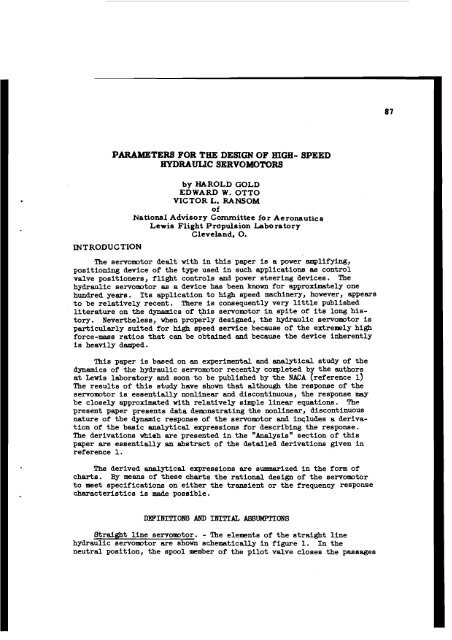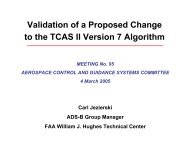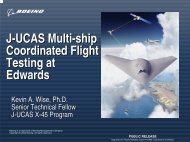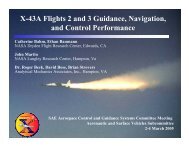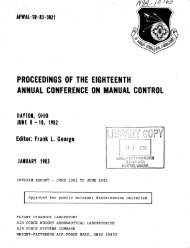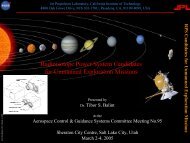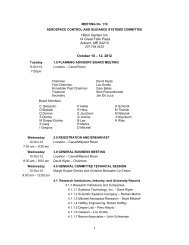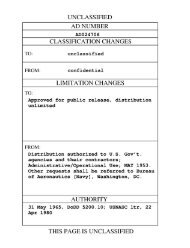Report of the Second Piloted Aircraft Flight Control System - Acgsc.org
Report of the Second Piloted Aircraft Flight Control System - Acgsc.org
Report of the Second Piloted Aircraft Flight Control System - Acgsc.org
Create successful ePaper yourself
Turn your PDF publications into a flip-book with our unique Google optimized e-Paper software.
INTRODUCTION<br />
PARAMETERS FOR THE DESIGN OF HIGH- SPEED<br />
HYDRAULIC SERVOMOTORS<br />
by HAROLD GOLD<br />
EDWARD W. OTTO<br />
VICTOR L. RANSOM<br />
<strong>of</strong><br />
National Advisory Committee for Aeronautics<br />
Lewis <strong>Flight</strong> Propulsion Laboratory<br />
Cleveland, 0.<br />
The servomotor dealt Kith in this paper is a power amplifying,<br />
positioning device <strong>of</strong> <strong>the</strong> type used in such applicatione as control<br />
valve positioners, flight controls and power steering devices. The<br />
hydraulic servomotor as a device has been known for approximately one<br />
hundred years. Its application to high speed machinery, however, appears<br />
to be relatively recent. There is consequently very little published<br />
literature on <strong>the</strong> dynamics <strong>of</strong> *is servomotor in spite <strong>of</strong> its long history.<br />
Never<strong>the</strong>less, when properly designed, <strong>the</strong> hydraulic servomotor is<br />
particularly suited for high speed service because <strong>of</strong> <strong>the</strong> extremely high<br />
force-mass ratios that can be obtained and because <strong>the</strong> device inherently<br />
is heavily damped.<br />
This paper is based on an experimental and analytical study <strong>of</strong> <strong>the</strong><br />
dynemics <strong>of</strong> <strong>the</strong> hydraulic servomotor recently completed by <strong>the</strong> authors<br />
at Lewis laboratory and soon to be published by <strong>the</strong> NACA (reference 1)<br />
The results <strong>of</strong> this study have shown that although <strong>the</strong> response <strong>of</strong> <strong>the</strong><br />
servomotor is essentially nonlinear and discontinuous, <strong>the</strong> response may<br />
be closely approximated with relatively simple linear equations. The<br />
present paper presents data demonstrating <strong>the</strong> nonlinear, discontinuous<br />
nature <strong>of</strong> <strong>the</strong> dynamic response <strong>of</strong> <strong>the</strong> servomotor and inqludes a derivation<br />
<strong>of</strong> <strong>the</strong> baeic analytical expressions for describing <strong>the</strong> response.<br />
The derivations wfiieh are presented in <strong>the</strong> "Analysis" section <strong>of</strong> this<br />
paper are essentially an abstract <strong>of</strong> <strong>the</strong> detailed derivations given in<br />
reference 1.<br />
The derived analytical expressions are summarized in <strong>the</strong> form <strong>of</strong><br />
charts. By means <strong>of</strong> <strong>the</strong>se charts <strong>the</strong> rational design <strong>of</strong> <strong>the</strong> servomotor<br />
to meet specifications on ei<strong>the</strong>r <strong>the</strong> transient or <strong>the</strong> frequency response<br />
characteristics is made possible.<br />
DEFINITIONS AFSD IKMT& ASSUMET'IONS<br />
Straight line servomotor. - The elements <strong>of</strong> <strong>the</strong> straight line<br />
hydraulic servomotor are shown schematically in f imre 1. In <strong>the</strong><br />
nkutral position, <strong>the</strong> spool member <strong>of</strong> <strong>the</strong> pilot valve closes <strong>the</strong> paesages


